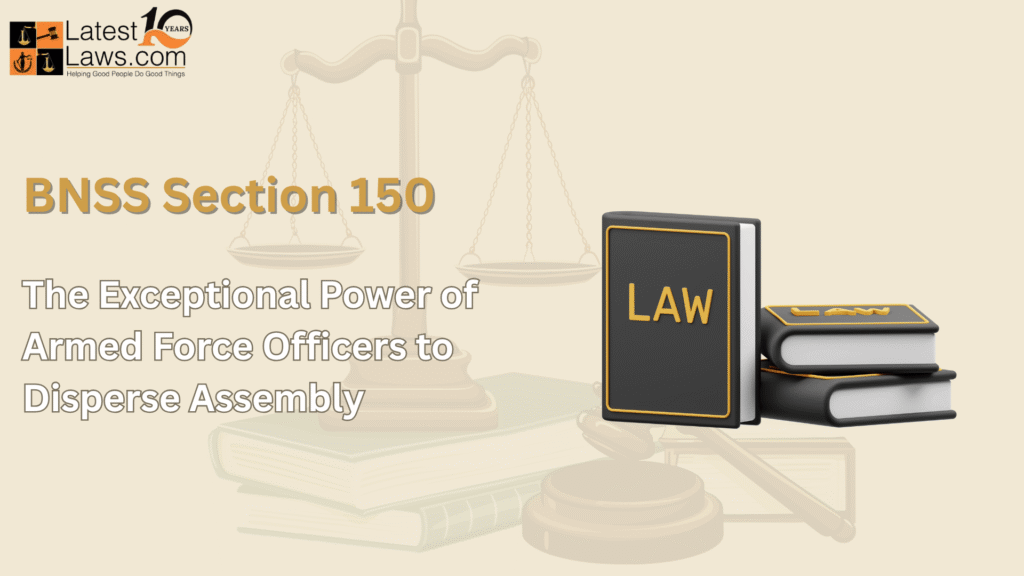1. Introduction
In any democracy, the right to assemble peacefully is a cornerstone of civil liberty. Yet, this right exists alongside the state’s equally crucial duty to maintain law and order. When assemblies spiral beyond peaceful intent—posing a direct threat to public safety—the law must intervene decisively but judiciously.
Within the framework of the Bharatiya Nagarik Suraksha Sanhita (BNSS), Section 150 emerges as a unique and powerful legal tool. It defines the authority and limitations of armed force officers to disperse assembly during moments of grave public danger.
This article explores when, why, and how this exceptional power can be used, outlining the balance between emergency action and constitutional restraint.
2. Decoding BNSS Section 150: What Does It Say?
BNSS Section 150 sets forth specific conditions under which an armed force officer may take direct action to control an unlawful or dangerous assembly. In plain terms, it allows such officers to intervene only when public security is manifestly endangered and when communication with an Executive Magistrate is not possible.
The provision is designed for emergencies—instances where immediate action is the only way to prevent chaos, destruction, or loss of life. It entrusts armed force officers to disperse assembly only in extreme circumstances where the civil command chain is temporarily inaccessible.
Key Conditions Before Invoking This Power:
- Public security must be manifestly endangered.
- An Executive Magistrate cannot be contacted.
- The officer must be commissioned or gazetted.
The primary purpose of authorizing armed force officers to disperse assembly under this section is to restore order and ensure offenders can be lawfully dealt with once normalcy returns. It’s a measure born of necessity, not convenience.
3. The Two Critical Preconditions for Action
What Is a “Manifest Danger to Public Security”?
This phrase sets a very high legal threshold. It does not apply to ordinary protests, small disturbances, or crowd gatherings that can be controlled by local police. Instead, it refers to severe and imminent threats—such as large-scale riots, armed uprisings, terrorist incidents, or violent mobs endangering lives and property.
When an officer determines that such a manifest danger exists, it reflects a situation where immediate, decisive action is the only path to restoring order. However, this determination must be made with utmost care. The law recognizes that the decision often lies in the judgment of the officer on the ground, but such discretion carries weighty moral and legal responsibility.
Thus, the power of armed force officers to disperse assembly under BNSS 150 is not about suppressing dissent; it’s about preventing catastrophic harm when ordinary law enforcement is overwhelmed.
When Is a Magistrate “Unable to Be Communicated With”?
The second essential condition under Section 150 addresses communication breakdown. It applies when the civil administrative link—represented by an Executive Magistrate—cannot be reached in time due to disruption, distance, or danger.
Imagine a scenario where riots erupt in a remote district, communication lines are down, or the Magistrate’s safety is compromised. In such moments, waiting for orders could cost lives. The law therefore permits armed force officers to disperse assembly independently, until contact with a Magistrate becomes possible again.
This ensures that security operations do not grind to a halt when civil control is temporarily out of reach. Still, it reinforces that such powers are temporary and situational, to be exercised only as a last resort.
4. Powers and Limitations: A Double-Edged Sword
BNSS Section 150 empowers certain military or armed officers with limited yet decisive authority. The intention is not to militarize civil law enforcement but to create a lawful bridge between military readiness and civil necessity during crises.
Powers Granted to Officers
When the stringent preconditions are met, the officer may:
- Disperse the assembly using the forces under their command.
- Arrest and confine individuals who continue to act violently or threaten security.
- Restore public order by removing immediate threats to life and property.
These actions, though forceful, are legally justified only when lesser measures are impossible. Every decision taken by armed force officers to disperse assembly must be guided by the principle of proportionality—using no more force than necessary to achieve stability.
The Overriding Limitation: The Primacy of Civil Authority
Despite these emergency powers, the law clearly establishes the superiority of civilian authority. Once communication with a Magistrate is restored, the officer must report all actions taken and follow the Magistrate’s instructions.
This legal design ensures that the role of armed force officers to disperse assembly remains strictly functional and temporary. Civil control must resume as soon as practicable, reinforcing democratic oversight.
The balance between immediate military intervention and ultimate civilian control is what prevents misuse. It underscores that Section 150 is not an open-ended license for force, but a structured emergency measure guided by accountability.
5. Understanding the Context: Why This Provision Exists
India’s diverse and vast social landscape sometimes witnesses spontaneous assemblies that can spiral into violent unrest. While the police typically manage such events, extreme circumstances—such as riots or insurgencies—demand quick decisions and strong enforcement.
In such cases, the authority of armed force officers to disperse assembly serves as a stabilizing mechanism. It prevents further loss of life, property destruction, and breakdown of governance. However, it also ensures that such powers do not replace civil administration.
Historically, similar provisions have existed under the Code of Criminal Procedure (CrPC) Section 131, from which BNSS 150 derives inspiration. The BNSS modernizes the legal language, ensuring that actions remain traceable, proportional, and under legal review.
In essence, the section balances two imperatives: the urgency of control and the restraint of power. It embodies the principle that military force may step in—but only to buy time for civil order to reassert itself.
6. The Ethical Dimension: Responsibility and Restraint
With great power comes immense responsibility. The use of armed force officers to disperse assembly raises not only legal but ethical questions. Officers must decide within seconds whether the situation justifies intervention. A wrong call could either allow anarchy or violate civil rights.
Hence, this provision relies heavily on the integrity, training, and discipline of commissioned officers. They are expected to evaluate the situation impartially, ensuring that actions are free from political influence or personal bias.
The ethical strength of this framework lies in its checks and balances:
- The power activates only under dire circumstances.
- It expires as soon as normal command resumes.
- It is subject to later scrutiny by civil authorities and, if needed, judicial review.
Through this design, the BNSS reaffirms that even in emergencies, rule of law must prevail. The authority given to armed force officers to disperse assembly is exceptional, not ordinary, and must always serve the public good—not convenience or coercion.
7. Comparison with Other Legal Frameworks
Globally, many democratic nations provide similar emergency provisions. The U.K.’s Public Order Act, the U.S. Insurrection Act, and similar laws in Australia or Canada allow the military to act in aid of civil power under strict supervision.
The BNSS 150 provision fits within this global legal pattern. It grants temporary powers to armed force officers to disperse assembly but binds them by legal accountability. The emphasis remains on minimal intervention and rapid transition back to civilian governance.
This alignment with international standards demonstrates that India’s legal modernization under BNSS is not about expanding state power, but refining it. It reflects a constitutional philosophy where public safety and individual freedom coexist through responsible governance.
8. Safeguards Against Misuse
Every exceptional power carries the potential for misuse. To mitigate this, the BNSS embeds procedural safeguards:
- Post-action reporting ensures transparency.
- Civil oversight ensures accountability.
- Judicial review ensures that any excess of force can be lawfully challenged.
Moreover, the law’s structure makes it clear that the powers of armed force officers to disperse assembly do not override fundamental rights—they merely operate within their limits to protect the public and restore peace.
This is where India’s democratic ethos stands firm: even during emergencies, actions remain tethered to legality and human rights.
9. Conclusion: A Necessary Power with Strict Safeguards
In conclusion, BNSS Section 150 represents a carefully balanced legal mechanism—one that empowers but restrains, authorizes but supervises. It acknowledges that certain crises demand swift, decisive action, yet it embeds that power within layers of accountability.
The authority granted to armed force officers to disperse assembly is thus both extraordinary and temporary. It exists to safeguard citizens when civil order collapses, but it yields back to civilian command as soon as possible.
By structuring such powers with precision and responsibility, the BNSS ensures that India remains a nation governed not by force, but by law—a democracy that endures even under the greatest strain.


